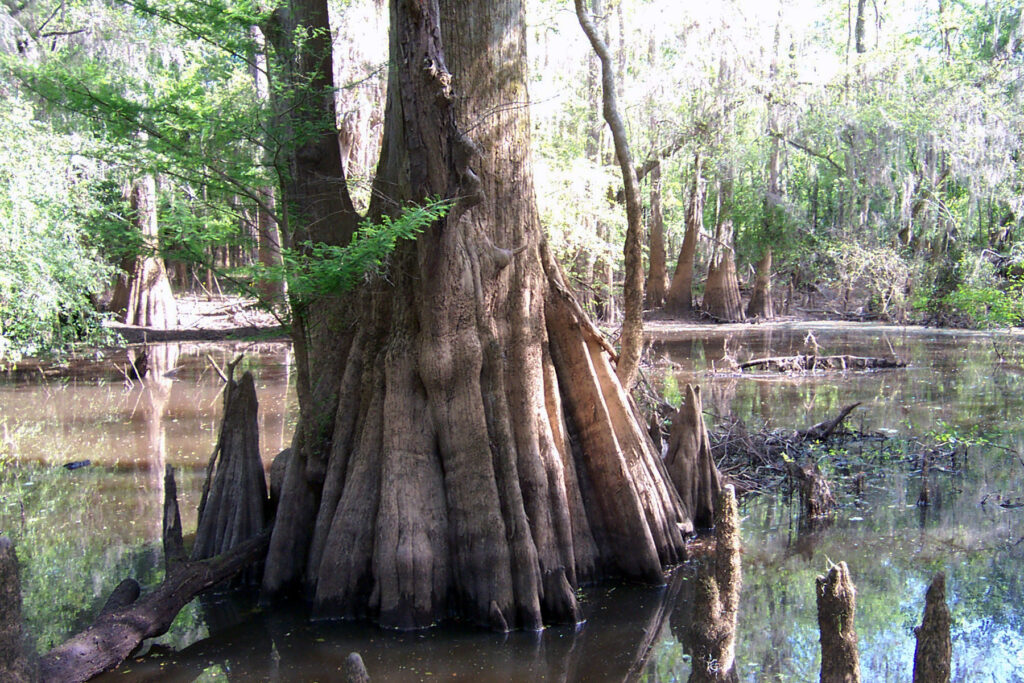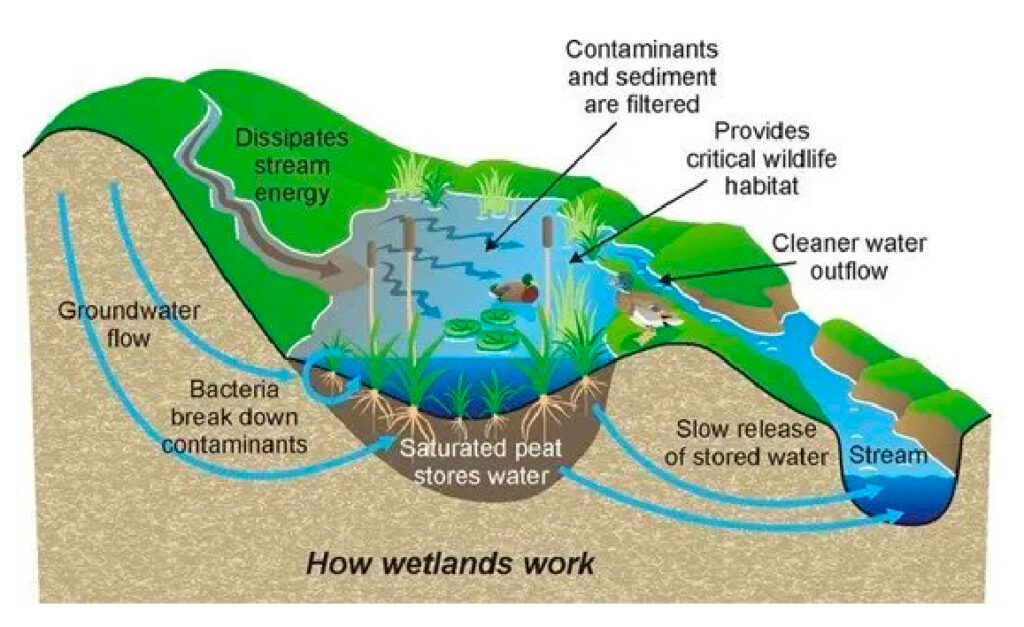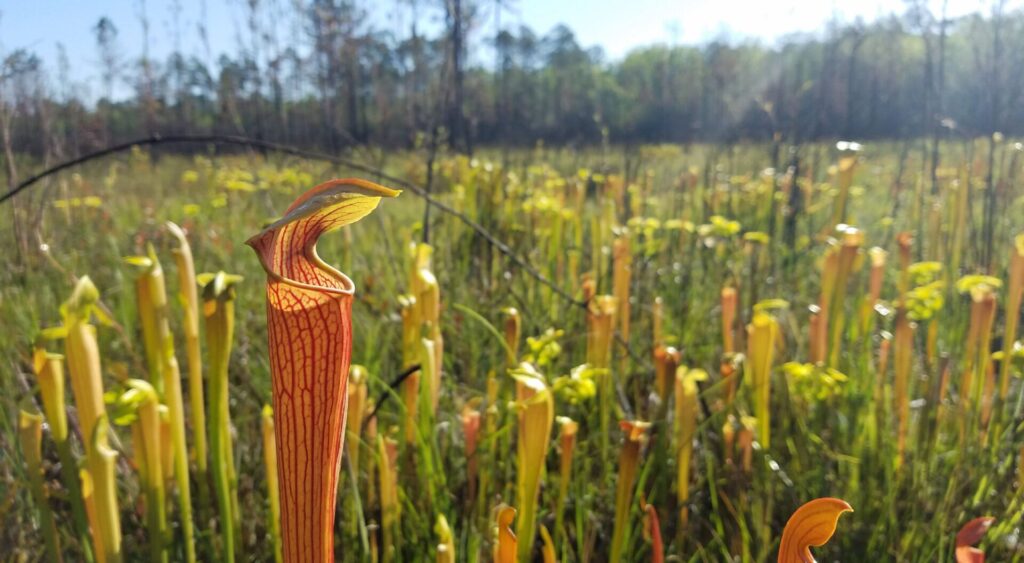By Rick Savage
Editor’s note: If you’re paying attention, you’ve noticed we recently featured several pieces on wetlands in both the Summer and Fall 2023 Native Plant News. The following article by the executive director of the Carolina Wetlands Association continues this trend and explains the impact to our wetlands from the NC legislature’s decision approving the NC Farm Act. – Laurel Bacogeorge, legal analyst with Vanguard, and Andrea Thunem, editor of the “Native Plant News.”
This article will explore recent North Carolina legislation and how it impacts our wetlands. We know wetlands are integral to healthy ecosystems but what if they are not protected and someone wants to build on them?
What happened?
Before last summer, North Carolina had a statute designating that all NC waters were under the jurisdiction of the state. This statute was enacted during the brief implementation of the Trump administration’s rewrite of the Waters of the U.S. under the Clean Water Act, which drastically decreased wetlands protections. When the federal rewrite happened, it prompted the NC Dept. of Environmental Quality to rapidly put rules in place to provide permitting and protection to the wetlands that were no longer federally protected.
Those NC wetlands protection rules were temporary and were not replaced by permanent rules. During that temporary period, the Carolina Wetlands Association worked with the Southern Environmental Law Center and other environmental groups to educate our NC legislators on the need to protect our wetlands.

Despite that work, NC legislators voted in favor of the Farm Act. S.B. 582, North Carolina Farm Act of 2023 (“Farm Act”), which followed suit after a recent Supreme Court ruling. The ruling (described below) changed the definition of wetlands to limit them. In effect, by changing the definition, the Supreme Court narrowed the meaning of protected wetlands to visual evidence: If you don’t see water, how do you know it is a wetland (a jurisdictional wetland); if you see water, but the water does not connect to a navigable stream, then it is not protected; or if it is during the growing season, there may be no water; but during the winter there may be plenty of water and then it is also not protected. Thus, the NC Farm Act does not protect wetlands any more than federal law.
The Supreme Court’s May 2023 decision in the Sackett vs. the EPA case resulted in more wetlands having unprotected status under federal law. What the Supreme Court did by changing the definition of the term Waters of the U.S. was essentially rewrite the Clean Water Act. The Southern Environmental Law Center issued this statement May 25, 2023, “U.S. Supreme Court sides with polluters, abandons basic protections for America’s clean water and communities.”
Why do wetlands matter?
The Carolina Wetlands Association describes how wetlands are linked with water quality and healthy ecosystems. Among the benefits of wetlands is that they help retain floodwater, stormwater, and storm surge. They also sequester carbon within the soil’s organic content. One of the most important functions of wetlands is the ability to purify water and preserve water quality. Despite the integral role of wetlands in maintaining healthy ecosystems, they continue to be at risk of impacts by development, lack of legal protections, pollution, and the negative influences of climate change.
How wetlands work

This figure from “Wetlands and Water Quality” illustrates how healthy wetlands function across the landscape. Chemicals and nutrients found in runoff are trapped and processed by sediment and vegetation in the wetlands. Nitrogen, phosphorus, and heavy metals found in both urban and agriculture nonpoint source pollution are captured, processed, and stored in wetland soils and plant growth in healthy functioning wetlands. Riparian wetlands also remove harmful bacteria, suspended materials, and pathogens from water prior to that water entering the stream environment [Klapproth, J. C, J. E Johnson. 2009. Virginia Cooperative Extension. Understanding the Science Behind Riparian Forest Buffers: Effects on Water Quality]. In addition, a healthy network of wetlands is capable of decreasing flooding downstream as the wetlands retain significant amounts of water. Biodiversity, water clarity, and public health are all benefitted through healthy riparian wetlands.
Coastal wetlands provide numerous ecosystem services, including water filtration, flood control, and coastal protection. Coastal wetlands contribute to healthy oceans and productive coastal regions. These services have quantifiable direct and indirect impacts to water quality. Tidal marshes, estuaries, and mangroves recharge groundwater supplies, filter sediment, remove contaminants, and also serve as nurseries and critical feeding and resting grounds for migratory species. [Millennium Ecosystem Assessment (2005) Ecosystems and Human Well Being: Synthesis. Island Press, Washington, D.C.].
Wetlands are also extremely important to mitigate the effects of hurricanes and severe flooding by protecting coastlines and absorbing floodwaters along rivers. During storm events, wetlands slow down soil erosion by reducing the speed of water that passes through them [North Carolina Division of Water Resources. 2018. NC Wetlands. Retrieved from http://www.ncwetlands.org/].

The many benefits maintained by riparian and coastal wetlands make their protection imperative, yet the historical degradation and current and projected threats to these habitats put them at risk.
The Biden administration’s rewrite of Waters of the U.S. is in limbo, as now it will take an act of Congress to change what the Supreme Court did.
What’s next? Our state’s wetlands now need targeted protection.
All is not lost, though: Landowners can still protect and restore wetlands. Download the Carolina Wetlands Association brochure to read a step-by-step guide, “A Landowner’s Guide to Wetland Restoration.” In North Carolina, we can continue to work with groups that protect our wetlands, and keep our legislators informed.
When visiting a wetland, ask, what if it were not protected and a developer wants to build here?
Preventing the exacerbation of climate change by protecting our natural environment should be our real focus.
By Rick Savage
Native Plant News – Winter 2023

Rick Savage is the executive director of Carolina Wetlands Association and past president of its board of directors. He has a master’s degree in systems engineering from Virginia Polytechnic Institute and State University and a Master’s of Natural Resources from North Carolina State University. His work with Carolina Wetlands Association has focused on vulnerable communities that get flooded along riverways in the coastal plains, to obtain funding to restore wetlands to mitigate flooding. Previously serving as a wetlands scientist, he led North Carolina wetlands research on behalf of the Environmental Protection Agency and monitoring programs for three southern states.
Editor’s Note: Read about Cypress Savannas, wetlands of flat-bottomed depressions, in “Fire Up That Wetland! Cypress Savannas in North Carolina,” Winter 2023 Native Plant News
